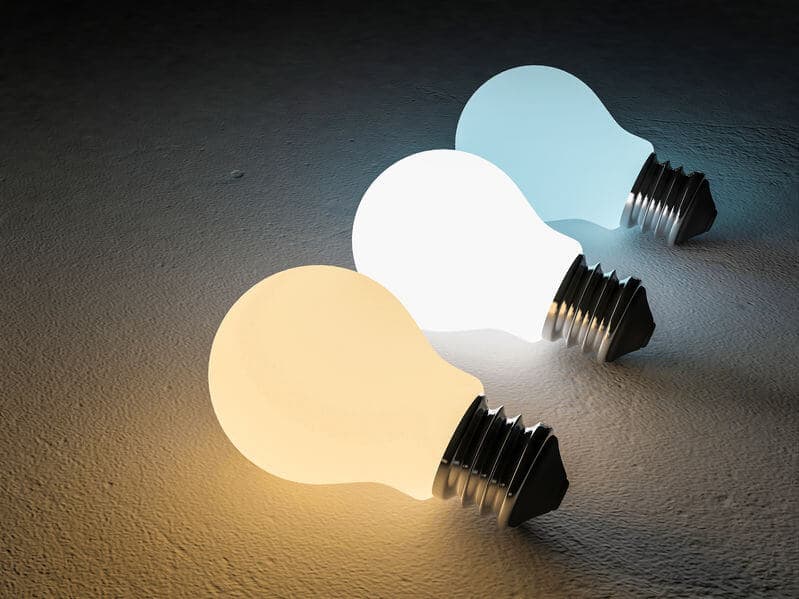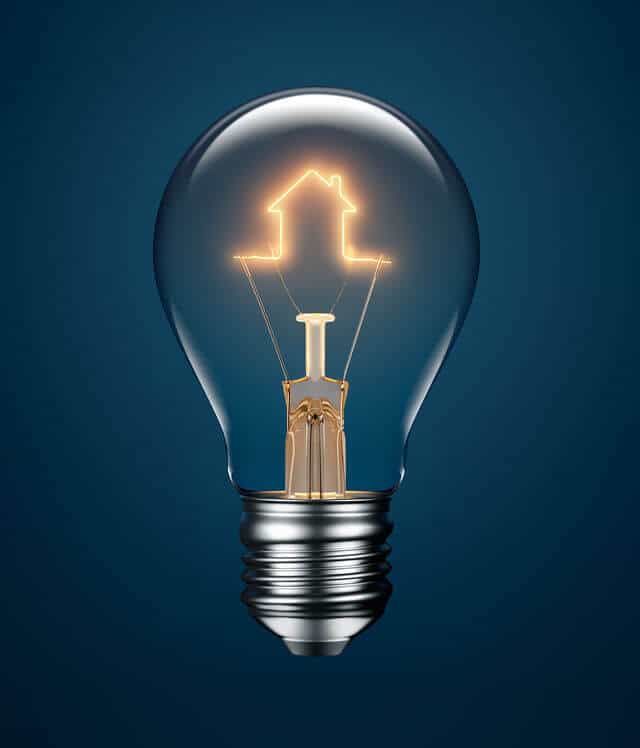There can be a little bit of confusion between what the difference is between an LED or incandescent bulb and which light bulb is the most energy-efficient one to use.
Incandescent light bulbs are the light bulbs that most of us call standard lightbulbs or the lightbulbs Edison invented. CFL is also known as a Compact Fluorescent lightbulb, and as the name implies, a compact bulb fluorescent light bulb. LED is a light bulb that uses light-emitting diodes.
Table of Contents
- LED, CFL, and Incandescent Light Bulbs Overview
- Approximate Cost For Different Lightbulbs
- About Incandescent Light Bulbs
- About Compact Fluorescent Bulb
- About LED Lightbulbs
- Related Content

LED, CFL, and Incandescent Light Bulbs Overview
If you are looking for a lightbulb it can be confusing as to what lightbulb to actually use. In fact, in the United States, some states may have laws about which lightbulbs can be actually used and sold in their states.
Overview of the three major types of lightbulbs:
- Incandescent bulbs – The incandescent bulbs are the old-fashioned typical lightbulbs that most of us grew up using in our homes. These were the only lightbulbs you could buy for a long time. These lightbulbs are not very energy efficient and do not last that long.
- Compact Fluorescent Lightbulbs (CFLs) – Compact fluorescent lightbulbs are the strange spiral bulbs that most people think about when looking at energy-efficient lightbulbs.
- LEDs – LED bulbs are energy-efficient lightbulbs, but they have an incandescent bulb’s look and feel that uses light-emitting diodes. They are considered the most energy-efficient lightbulbs to use.
Approximate Cost For Different Lightbulbs
Different lightbulbs will cost significantly different when using the lightbulbs with electricity. The chart below calculates the average cost per hour for lightbulbs.
The electricity rate we have used is the average cost in the United States or 13.19 cents per kilowatt per hour. This rate and cost can, of course, change depending on your actual cost of electricity.
| Lightbulb Types | Average Hours Use Per Lightbulb | Electric Usage/hour (average) | Cost/hour (average) | Average Cost to Use 10 lights 7 hours per month |
| Incandescent | 1,000 | 60 watts | .0079 USD | 16.62 USD |
| CFL | 10,000 | 14 watts | .0018 USD | 3.88 USD |
| LED | 25,000 | 10 watts | .0013 USD | 2.77 USD |
As you can see from the above table, the LED lightbulb will last the longest and uses the least amount of electricity per hour. We can say it is the most energy-efficient of all the lightbulb types.
By changing just ten lights to LED from Incandescent over one year, your electricity saving cost is 166 USD; when you have more than 10 lights, the electrical savings cost per year is significant.
When considering which lightbulb to use, you should not look at just the lightbulb’s cost but the overall costs of using the bulb. There are huge electrical savings when you use the LED lightbulb, especially when compared to the incandescent lightbulb.

About Incandescent Light Bulbs
When most people talk about a standard lightbulb, they talk about an incandescent bulb. This incandescent bulb has existed since Thomas Edison patented the lightbulb in 1879.
An incandescent light bulb is a light bulb that emits light due to being heated. Incandescent light is an electric light bulb with a wire filament that is heated to give off light; it is the glow of the heated wire that emits the light coming from the light bulb.
An incandescent lightbulb can come in several sizes, but the standard light bulb is E-26. To learn more about the standard light bulb and other incandescent light bulb sizes, you can read What is the Standard Light Bulb Base? Different E -Socket Types by clicking here.
The End of an Era: U.S. Bids Farewell to Incandescent Light Bulbs
As we turned the page to August 1, 2023, the United States embarked on a significant environmental stride – the nationwide ban on the production and sale of incandescent light bulbs. This move, aimed at enhancing energy efficiency across the nation, marks a pivotal shift in how Americans light up their homes and workplaces.
The Journey to the Ban
The roots of this ban trace back to 2007, under the administration of former President George W. Bush, who first proposed this initiative. In the years that followed, the policy faced its ups and downs, notably with the Trump administration rolling back the ban. However, the Biden administration revived and updated this eco-friendly regulation last year, cementing its commitment to energy conservation and a sustainable future.
Why Incandescent Bulbs Fell Out of Favor
Incandescent light bulbs, while once a staple in lighting, have long been known for their inefficiency compared to their contemporary counterparts – LEDs (Light Emitting Diodes) and fluorescents. The primary drawback lies in their operational mechanism: incandescent bulbs increase in brightness as they consume more power.
This correlation between brightness and power consumption renders them less energy-efficient. Typically, the brightness of these bulbs is measured in watts, a unit that is becoming increasingly anachronistic in the age of energy-saving lighting solutions.
Exploring the Varieties of Incandescent Bulbs
Despite their phased-out status, it’s interesting to note the diversity that existed within the realm of incandescent bulbs. Some common types included:
- Standard A or A-Shape: The classic bulb shape that most people envision when they think of incandescent bulbs.
- Globe: These bulbs were larger and rounder, often used in vanity lighting and decorative fixtures.
- PAR (Parabolic Aluminized Reflector): Commonly used in spotlights and floodlights.
- Reflector: Designed to direct light in one direction, these bulbs were typical in recessed lighting and track lighting.
- Candelabra: Smaller with a decorative flair, these bulbs were often found in chandeliers and sconces.
- PS-Shaped, S-Shaped, Bi-Pin: These specialized forms catered to specific lighting needs and designs.
Looking Ahead
The ban on incandescent light bulbs is more than just a regulatory change; it’s a cultural shift towards more sustainable living. As the United States moves away from these energy-hungry bulbs, the focus is now on more efficient lighting solutions that not only save energy but also reduce our environmental footprint. This transition is a crucial step in the nation’s journey towards a greener, more sustainable future.
About Compact Fluorescent Bulb
A CFL or a compact fluorescent light is also called an energy-saving lightbulb. The CFL is basically an energy-saving fluorescent lightbulb that was designed to replace the incandescent lightbulb.
The CFL lightbulb will use a curved fluorescent-filled glass tube that fits into the incandescent bulb’s space. This is like a mini fluorescent light similar to fluorescent lights you may find on a ceiling.
Compared to the incandescent lightbulbs, the CFL will give off the same amount of visible light, but they will only use 150 to 130 electrical power. They are considered energy-saving as they use less energy than an incandescent lightbulb.
An issue with CFL lightbulbs is that they can take a while to heat up to full brightness. Once the electricity starts moving inside the CFL lightbulbs, they will use 70% less energy than the incandescent bulbs.
One downside of the CFL lightbulbs is that they contain very toxic mercury; if you break a CFL lightbulb, it can be dangerous. The toxic mercury also complicates the disposal of CFL lightbulbs.
Some countries have regulated the disposal of CFL lightbulbs. These extra garage disposal requirements add to the overall costs of the CFL lightbulbs. Even though energy-saving lightbulbs, additional energy and other resources are used for CFL lightbulb waste disposals.
About LED Lightbulbs
The LED lightbulb is an electric lightbulb that can use that uses light-emitting diodes. The light-emitting diode code is a semiconductor light source that lights up when the current flows through it.
One of the advantages of LED lightbulbs is that they have a lifespan that is much longer than the equivalent incandescent lightbulb; they are also slightly more efficient than CFL lightbulbs.
LED lightbulbs are where the growth for lightbulbs will be over the next decade. This is because the LED lightbulbs are very similar to the incandescent lightbulbs, but they use only about 10% of the energy.
LED lightbulbs cost you more than an incandescent light bulb; in many cases, the cost is double. Recently LED lightbulbs have been very popular because they are more efficient than incandescent bulbs and last much longer; over the long term, these lightbulbs can give you significant savings.
And example if an American home has about 40 lightbulbs, if you replace all your light bulbs with LED so you could save about $250-$300 a year and energy cost. For many, these cost savings per year more than make up the difference in the cost of the LED lightbulbs.
Another advantage is that LED technology continues to improve. As this is a huge growth area for lightbulbs, expect to continue to see major developments coming with LED bulbs in years to come.
Mondoro has its own UL-certified lamp factory outside Hanoi, Vietnam. In the factory, we assemble UL lamps (table, floor, and other portables), we also make some of our own shades.
If you are interested in finding out more about how we can help you manufacture some UL-certified lamps, please contact Anita by clicking here or write her directly at her email by clicking here. We would love to hear from you and hear how we can help you.
Find out more about how Mondoro can help you create, develop, and manufacture excellent home decor and home furniture products – don’t hesitate to contact me, Anita. Check out my email by clicking here or become a part of our community and join our newsletter by clicking here.
Mondoro gives out a FREE Lookbook to anyone interested. You can receive a copy of our latest Lookbook by clicking here.
Listen to our Podcast called Global Trade Gal. You can find it on all major podcast platforms. Try out to listen to one of our podcasts by clicking here.
Subscribe to our Mondoro Company Limited YouTube Channel filled with great videos and information by clicking here.
Related Content
What is the Standard Light Bulb Base?
The standard light bulb base is E-26. The E-26 light bulb base must use an E-26 socket; you will find an E-26 socket on many table and floor lamps sold in the United States. The E-26 socket is also known as the standard socket. Besides the E-26 lamp holder socket, the other significant U.S. lamp holder socket types are E-12, E-19 and E-39.
You can learn more by reading What is the Standard Light Bulb Base? Different E -Socket Types by clicking here.
How Do You Make A Bamboo Lamp Shade?
To manufacture or make bamboo lampshades, you need to 1) properly prepare the bamboo materials, 2) build a metal frame, 3) wrap the metal frame, 4) secure the bamboo on to the metal frame, 5) spray color on top of the bamboo shade if you desire the lampshade to be a color other than natural and 6) spray a top coat on the entire shade to protect the bamboo shade’s finish.
You can discover more at How Do You Make A Bamboo Lamp Shade? All About Bamboo Lampshades by clicking here.

